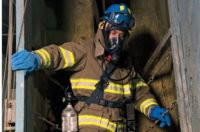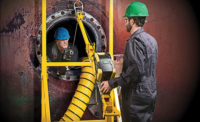Broadly speaking, a confined space is an area that is large enough for a worker to enter and do work, but that is difficult to get in and out of easily, and not designed or intended for regular occupancy. Examples of potential work spaces that fit this definition include: storage tanks, silos, reaction vessels, enclosed drains, manholes, ship holds, sewers, mines, and many utility or furnace rooms with facility operating systems. While all of these examples can be considered a confined space that professionals often work in, not all confined spaces are the same.
Permit vs non-permit
OSHA classifies a confined space in one of two categories: permit required or non-permit required confined spaces.
Permit required confined spaces are complex. Even though they meet a simple definition of a confined space, they can also contain potentially hazardous materials and/or gases. Permit required confined spaces are classified by their physical and mechanical makeup, are inherently dangerous and could cause entrapment, serious injury or death. These areas are typically restricted and require special training, ventilation, gas monitoring, communications, personal protective equipment and emergency extraction equipment to ensure worker safety.
To meet the OSHA definition of a confined space, it must meet other criteria too. This includes being large enough to enter and work in, yet must have limited or restricted entrance and exit. The space must also not be designed or intended for continuous worker occupancy.
Non-permit required confined spaces can be hazardous and require different precautions than those recognized as needing permits for entry. These spaces include tight work areas with reduced air flow and may have the potential to contain hazardous or combustible materials. However, they don’t typically include ventilation, entrapment or hazards that can engulf a worker.
The potential dangers to workers in these spaces will depend on the work that is being done. Welding, cutting, grinding, drilling, sanding or any high-energy activity can create high levels of noise, respirable particles and/or toxic aerosols that can buildup to hazardous levels. This can have serious impact to worker health and safety.
Dust and particulates
Particles 10 microns in size and smaller become airborne easily, potentially being inhaled into a worker’s respiratory system. Particles that are 4 microns (respirable) or smaller are able to enter the human respiratory tract and penetrate deep into the gas exchange region of the lungs. These small particles are typically generated from high-energy work like cutting, grinding and sanding of materials or through high temperature processes such as welding or in foundries.
Airborne dust and particulates are often made up of hazardous materials including but not limited to hexavalent chromium, lead, manganese, iron oxides, nickel, cadmium, silica, diesel particulate matter. Many of these materials are known to cause damage to internal organs in the human body including lungs, kidneys, liver, brain, nervous system and eyes. Many materials like silica are known to cause cancer.
When generated in confined spaces, these dusts and particulates can build quickly. It is important to monitor the particle concentration that a worker is being exposed to so action can be taken to reduce exposure and maintain worker safety.
Determining exposure
The best method for quickly determining exposure levels in real-time is with the use of direct reading instruments. Real-time instruments can help workers quickly determine if the concentration of respirable particles is increasing in the work area and within the breathing zone of the worker. If so, workers can employ engineering controls to reduce exposure.
Even when engineering controls such as increased ventilation or dust evacuation methods are in place, it is important to monitor worker exposure in real-time to ensure the controls are effective or if further adjustments are necessary.
Focus on silica dust
In recent years, there has been a growing focus on personal monitoring of workers for silica dust and ultrafine particles like diesel particulate matter (DPM). In 2016, OSHA reduced the personal exposure limit (PEL) of silica dust to 50 µg/m3 averaged over an eight-hour period. This is half of the limit of the previous standard revision. OSHA also added an action level of 25µg/m3 averaged over an eight-hour period.
Silica exposure is potentially acute in confined spaces. The potential of limited air movement and minimal ambient air circulation in these spaces allows particulate concentrations to build quickly. Now, with the new lower PEL and action levels for respirable silica, OSHA limits can be reached over a shorter period of time with high respirable particle concentrations in confined spaces.
Underground mining
Perhaps one of the best recognized confined spaces is underground mining. With the new silica standards being adapted, underground mining operations have increasing concerns over respirable crystalline silica dust being generated by normal mining operations. Compounding the need for respirable dust monitoring is the increase in black lung disease in coal miners around the world from long-term exposure to respirable coal dust.
Ultrafine particles such as diesel particulate matter (DPM) are also a potential compounding factor for particulate monitoring in confined spaces. DPM is classified as a possible carcinogen by the National Institute for Occupational Safety and Health (NIOSH) and the U.S. Environmental Protection Agency (USEPA). The operation of diesel-powered equipment in underground mines and other confined or enclosed spaces can pose additional need for real-time personal exposure monitoring of particulates in the worker’s breathing zone.
Intrinsic safety
Confined spaces in the underground mineral/metals mining, coal mining, petrochemical and oil and gas industries have added complexity to the jobs of workers performing duties in potentially volatile or explosive environments where gases, fuels, or other potentially combustible materials are likely to be present.
As a result, many work areas in these types of industries require electronic instruments, such as personal aerosol monitoring instruments, to be certified for intrinsic safety (IS). This means they are designed to eliminate the potential to cause ignition of specific gases or other combustible materials within the work area. In work areas that are designated as explosive or potentially volatile, only intrinsically safe instruments that have been certified by IECEx / ATEX or CSA are allowed.
Certifications for real-time personal exposure monitors requires specific design requirements that have withstood rigorous testing and verification. Few real-time particle monitoring instruments, such as the SidePak™ AM520i Personal Aerosol Monitor from TSI, can meet the EX certification standards for applications requiring intrinsically safe instruments in confined spaces.
Summary
Monitoring workers for exposure to respirable particulates that include dust, metals, crystalline silica, welding fumes, diesel particulate matter and other potentially harmful particles is being driven by tighter regulations effecting almost every industry.
Employers are more attentive than ever regarding the personal exposure of workers. Workers themselves are being educated on potential dangers and health risks of respirable, fine, and ultrafine particles in the workplace and how to avoid exposure. Instrument companies such as TSI are developing new personal exposure monitoring instruments that are certified for intrinsic safety to help companies obtain the critical personal exposure data needed to help keep workers safe—even in confined spaces.



